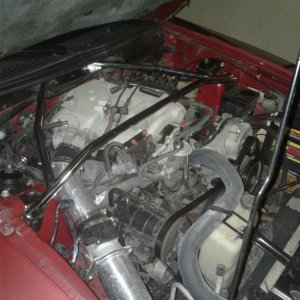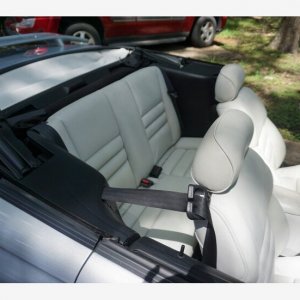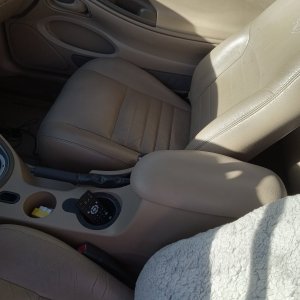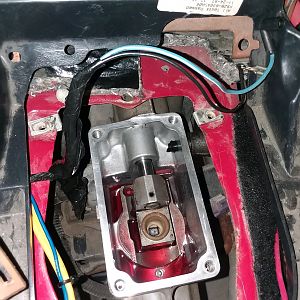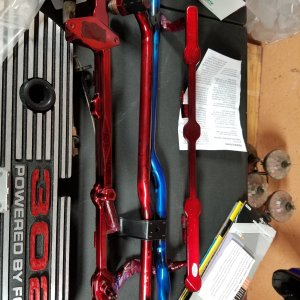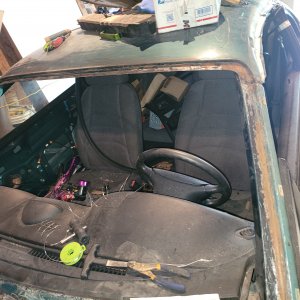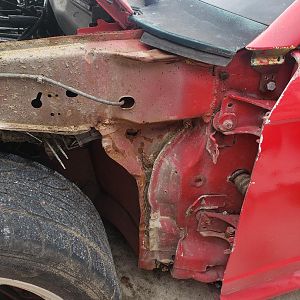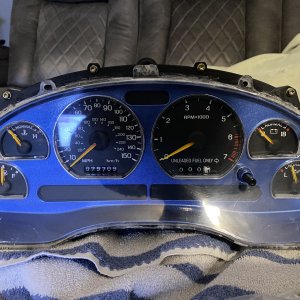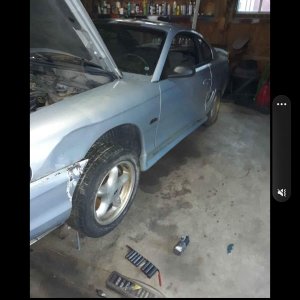For some of you Mustang folks out there who may be new to wrenching, here is a relatively simple project that can improve the performance of your Mustang. If your car has over 100,000 miles and still has the original oxygen sensors, it wouldn't be a bad idea to replace them as part of a good tune-up.
As far as tools, all you'll need to complete the job is:
- A good jack and jackstands
- A 7/8" open-ended wrench or special O2 sensor socket
These socket wrenches are available at the auto parts store, and have a slot in them for the O2 pigtail.
First, simply jack up the car and secure it safely with a pair of jackstands. You can put the stands under the subframes, engine crossmember, or other secure place on the car.
Then, it's time to locate your O2 sensors. They are located on your exhaust mid-pipe all the way forward near where it attaches to your headers. If you have a factory catalytic h-pipe, they are located forward of the two forward-most cats. I have a Magnaflow catalytic x-pipe on my daily driver, so I only have two cats and the O2 sensors are super easy to get to.
Here's the old driver side sensor:

Here's what it looks like from a bit further back:

Here's the passenger side sensor:

...and from a bit further back:

After you've located them, simply disconnect the two sensors. All you have to do is push down the little tab and pull them apart.

Then grab your 7/8" wrench and unscrew the sensors. If it's too tight a fit and you can't get a wrench on them, the special O2 sensors socket might be a better choice here.

Now you need to grab your two new oxygen sensors and reinstall them. A word of caution/advice here - USE ONLY FACTORY ORIGINAL EQUIPMENT OXYGEN SENSORS. I've discussed this at length with several knowledgable folks who I trust to know precisely whay they're talking about, including one who owns a dyno facility and has been tuning cars for over ten years. They say that the calibration of other common aftermarket sensors that can be purchased at auto parts stores is not as accurate, and does not always send the appropriate signal. The OEM Ford sensors cost a bit more, but I think it's worth it for the peace of mind knowing they'll work correctly.
I got a great price on mine through the website below. I paid ~$57 per sensor, with retail being $113 each.
http://www.directfordparts.com/partlocator/index.cfm?siteid=214290
You can use their parts locator to find the sensors for your car, and when you place your order they will ask you for the VIN number on your car. They use this to ensure you get exactly the right part for your car. I got great customer service, fast shipping, and a great price.
Here are the two sensors I installed. These are the correct Ford part numbers for a 94-95 Mustang GT with manual transmission.


Now just reinstall your new sensors and reconnect the pigtails. Don't wipe off the anti-seize on the threads! That helps keep the threads from corroding and seizing in your h-pipe.
Driver side installed:

Passenger side installed:

Your done! Take the car down off the jackstands and go for a spin. Great job! :thumbsup:
Paul.
As far as tools, all you'll need to complete the job is:
- A good jack and jackstands
- A 7/8" open-ended wrench or special O2 sensor socket
These socket wrenches are available at the auto parts store, and have a slot in them for the O2 pigtail.
First, simply jack up the car and secure it safely with a pair of jackstands. You can put the stands under the subframes, engine crossmember, or other secure place on the car.
Then, it's time to locate your O2 sensors. They are located on your exhaust mid-pipe all the way forward near where it attaches to your headers. If you have a factory catalytic h-pipe, they are located forward of the two forward-most cats. I have a Magnaflow catalytic x-pipe on my daily driver, so I only have two cats and the O2 sensors are super easy to get to.
Here's the old driver side sensor:
Here's what it looks like from a bit further back:
Here's the passenger side sensor:
...and from a bit further back:
After you've located them, simply disconnect the two sensors. All you have to do is push down the little tab and pull them apart.
Then grab your 7/8" wrench and unscrew the sensors. If it's too tight a fit and you can't get a wrench on them, the special O2 sensors socket might be a better choice here.
Now you need to grab your two new oxygen sensors and reinstall them. A word of caution/advice here - USE ONLY FACTORY ORIGINAL EQUIPMENT OXYGEN SENSORS. I've discussed this at length with several knowledgable folks who I trust to know precisely whay they're talking about, including one who owns a dyno facility and has been tuning cars for over ten years. They say that the calibration of other common aftermarket sensors that can be purchased at auto parts stores is not as accurate, and does not always send the appropriate signal. The OEM Ford sensors cost a bit more, but I think it's worth it for the peace of mind knowing they'll work correctly.
I got a great price on mine through the website below. I paid ~$57 per sensor, with retail being $113 each.
http://www.directfordparts.com/partlocator/index.cfm?siteid=214290
You can use their parts locator to find the sensors for your car, and when you place your order they will ask you for the VIN number on your car. They use this to ensure you get exactly the right part for your car. I got great customer service, fast shipping, and a great price.
Here are the two sensors I installed. These are the correct Ford part numbers for a 94-95 Mustang GT with manual transmission.
Now just reinstall your new sensors and reconnect the pigtails. Don't wipe off the anti-seize on the threads! That helps keep the threads from corroding and seizing in your h-pipe.
Driver side installed:
Passenger side installed:
Your done! Take the car down off the jackstands and go for a spin. Great job! :thumbsup:
Paul.

